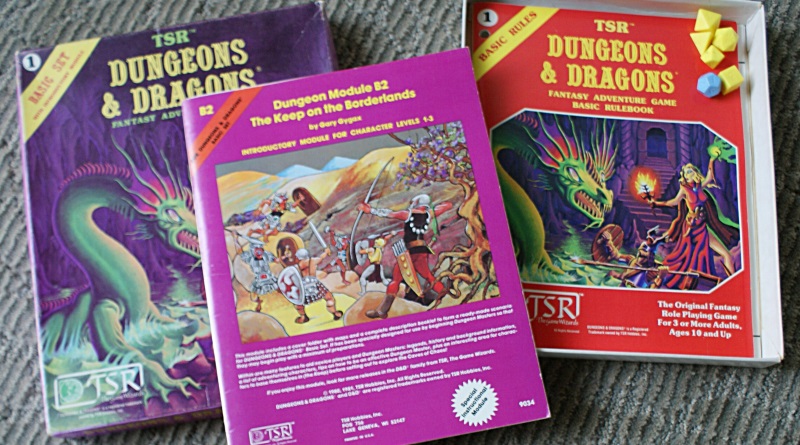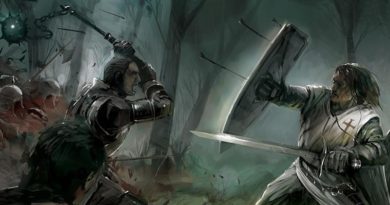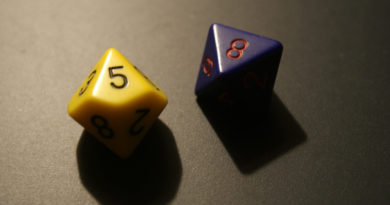How to use a BX Combat Matrix for Everything
Beating an AC of “Hard”
I like devising things that plug into an existing “system” without undue modification. The Combat Matrix can be used for any test. Consider that the BX table simply presents 13 steps of difficulty which happen to be rated from 9 through -3. In practical terms tasks may be rated from Easy to Hard, and for simplicity, Test Numbers 9 through 0 present an adequate range of Check Roll values.
The AC Number is converted into a Test Number
|
Character’s Level |
Test Number |
||||||||||||
|
9 |
8 |
7 |
6 |
5 |
4 |
3 |
2 |
1 |
0 |
-1 |
-2 |
-3 |
|
|
Difficulty |
Easy |
Hard |
|||||||||||
|
Normal Man |
11 |
12 |
13 |
14 |
15 |
16 |
17 |
18 |
19 |
20 |
20 |
20 |
20 |
|
1st to 3rd |
10 |
11 |
12 |
13 |
14 |
15 |
16 |
17 |
18 |
19 |
20 |
20 |
20 |
|
4th + Higher |
8 |
9 |
10 |
11 |
12 |
13 |
14 |
15 |
16 |
17 |
18 |
19 |
20 |
In a simple scenario a Player whose character happens to be a 3rd Level Fighter wishes to climb a vine covered wall. The Game Master must pick a Test Number from 9 through 0 which represents the difficulty of this task. If the Game Master picks a 5, moving down on the chart to the 1st to 3rd row one finds a Check Roll of 14 is required, and the Player must roll 14 or better using a d20.
That’s it!




This is brilliant – I can’t believe I’ve never thought of this before. The great part is that because it’s based on the Basic combat matrix, it progresses by level, not class (though I suppose one could parse out the “4th + Higher” into levels 4-6, 7-9, 10-12, and 13-15).
I suppose one might also allow attribute bonuses? Like STR bonus for climbing the vine or INT for doing something smart?
Deftly done!
Glad you like it! The idea came out of our other little side project. How many times have I heard a player say “I leap through the open window” and had no way to admin that action/test easily. This table kind of solves that conundrum. I chose the matrix from the Basic Book and in that the classes attack numbers are the same at those low levels, 1-3 anyway, so yeah its kind of classless and needs expanding. Yeah, why not allow the ability bonus for context, like trying to read ancient runes, definitely an INT related test.
I like the basic idea, though I’d probably use every other column to determine difficulty rather than all of them. Label them easy, average, challenging, hard, daunting, impossible and you’ve pretty much got the full range covered.
Hi Robert, sure, its adaptable.
This is brilliant. I don’t think this can be said enough. I could see this, coupled with a sort of ‘good at’ classification for a particular task, replacing most any skill check system that can be used with B/X.
Hi Frotz, thanks and yeah, we do kind of need something like this for those “I leap through the window” situations that we all hear as DMs. How hard is it to leap through that window? Now we have something to pin a number and a check roll on, and we already know the mechanic. 🙂
Quite a few skill driven game systems have a tiered difficulty systems with (for instance) 5 to 6 skill levels (trivial, easy, average, hard, very hard, daunting for instance). These skill levels tend to be grouped 2-3 die roll values apart (depends on your die mechanics).
In one system, they have the notion of a UTP – Universal Task Profile. It’s simply a formalized shorthand for declaring a skill test (and in some systems, the combat mechanics use the same system as other skills).
The UTP concept means I can do something like this in my module description:
To Operate The Rusted Portcullis, Very Hard, Strength, 1d6 rounds, hazardous. If the roll misses by 5, the character suffers 1d3 damage from strain and all physical activities have a -1 penalty until a night’s rest have occurred.
The format is:
, , , , .
Other qualifiers:
Opposed (an example would be a PC and an NPC arm wrestling – to win is an average task with STR as a modifier and because it is opposed, PC adds his str mod and subtracts the NPC competitors str mod to arrive at the total mod)
Uncertain (an example would be a PC reading an ancient tome written in a long dead language – a hard or very hard task using INT, and uncertain means the player rolls a check and the DM rolls one behind his screen – both fail -> clear failure, either fails but not both -> partial success, both succeed -> complete success – the uncertain part is that the player never knows what the GM rolls so he only knows one of two possible results apply)
Having a standard task description method means a ref can a) write modules where tasks are clear without having to imagine an exact difficulty each time (just a word describing very easy to daunting) and b) the ref can make up tasks easily on the spot with some consistency. I guess c) would be you can build up a small reference page that has frequently seen tasks for reference for consistency over time.
I know B/X was table heavy and sometimes the tables are non-linear for flavour so abstracting to a simplified skill system might feel a bit off, but the utility far outweighs the pain. And the ability to ref all these situations without ever having to look at a chart (if the difficulty levels are standardized) is an amazing accelerator to the game and that means smoother combats and other activities.
BX Mechanics is easy if you are using descending AC.
d20 + modifiers + target’s AC = THAC0 score or greater to hit.
Other variations.
d20 + modifiers + BAB (basic Attack Bonus) + target’s AC=19 or greater to Hit.
You don’t need a table. Just remember either formula.